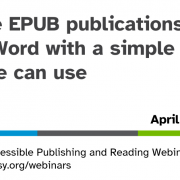If Accessibility Is So Easy Now, Why Is It Still So Hard?
This post was kindly submitted by Bill Kasdorf, Principal at Kasdorf & Associates
I recently served as Guest Editor for the January 2018 issue of Learned Publishing, which is devoted entirely to the subject of accessibility. One of my roles, in addition to recruiting about half of the articles, was to contribute one.
Since I’m a consultant and work with a lot of different publishers, organizations, and service providers, the LP editors suggested that I try to quantify the costs and “level of effort” to make a publication accessible. How much does it cost to add image descriptions? How much does it cost to get MathML for equations? What’s the level of effort and cost to provide correct tagging—the structural semantics that assistive technology depends on? And so on.
I suspect that most people reading this blog on Inclusive Publishing are smiling and shaking their heads, thinking “good luck with that.” Not only will people not tell you what they pay, or what they charge, there is no one cost for any of those things—not to mention all the other things that can come into play, like closed captioning and transcripts for video, for example. The answer is always “it depends.”
Which is not helpful.
Accessibility is so much easier now! Isn’t it?
In addition to my consulting work, I participate in lots of industry standards initiatives and working groups. I’m very aware of current standards, and I see them coming. The result, due to my natural optimism, is that I have a tendency to say “Accessibility is way easier now than you realize! We finally have good clear specifications like EPUB Accessibility 1.0, and many specs and standards are built on top of the fundamental features of the Open Web Platform like HTML and WCAG and WAI-ARIA, and specifications are so much better aligned globally! And they’re based on technologies that publishers and their suppliers already use anyhow! And there’s help out there, like Benetech’s Global Certified Accessible program and the Ace by DAISY checking tool, to help you get things right!”
This is intended to be helpful.
And all that is true. But this is when my good friend Tzviya Siegman says “Bill! Quit telling people it’s easy! It’s not easy!”
And of course, as usual, she’s right.
Okay, it can still be hard.
It was clear what I really needed to write about: “Why accessibility is hard, and how to make it easier.”
Researching and writing that article was really fun, and illuminating. I interviewed a hand-picked group of people—trade, scholarly, and educational publishers and leading service providers—that I know to be working hard on accessibility, who I knew could provide me with good insights, and who I could trust to give me honest answers.
And they knew they could trust me not to divulge any proprietary or sensitive information. I needed them to be able to pull back the curtain and let me see into the details of what they do.
Boy, did they.
Successful publishers are working hard on this.
Because of the developments I cited above, it is actually true that many publishers have workflows that can create EPUB 3s that are pretty darn close to meeting accessibility requirements. Close but no cigar.
The folks that are making the best progress on this are devoting lots of effort into documentation and training. One big educational publisher I interviewed provides extensive accessibility education, which includes workshops, training sessions, and even office hours when staff and vendors alike can talk to accessibility experts. Another one commented on how often they have to fix the work their vendors do, and how bizarre it is that they have to train vendors that are usually more technically expert than the publisher is.
The top challenge: getting image descriptions right.
Issue number one, to nobody’s surprise, is image descriptions. You may think the issue is just that they need to do them. But there’s way more to it than that. They need to understand how to do them properly, and when not to do them. Don’t just repeat the caption in the alt text—how annoying is that, to have it read to you twice by your screen reader? The image description shouldn’t just say what the image is, it should say what it is there for, what it is trying to convey within a given context. This can require two distinct types of expertise: subject matter expertise, and an understanding of what a user of assistive technology needs.
Plus, there is a huge variation in what is involved in creating image descriptions based on the nature and purpose of the image. A major educational publisher provided me with documentation showing that the most complex image descriptions, when created offshore, cost 11.5 times as much as the simplest ones; when created domestically, the most complex image descriptions cost a whopping 23.5 times as much as the simplest ones!
Involve the author, even if they don’t do it perfectly.
Most publishers are skeptical of getting authors to supply image descriptions, and of course for some types of publishing the authors don’t even provide the images in the first place. But who knows better why an image is in the book than the author? The University of Michigan Press has actually made excellent progress on this. For certain books, supplying image descriptions is in the author contracts, and they have trained editors who work with the authors to guide the authors on how to do them properly. They just need some copyediting and QC like the rest of the manuscript.
This is exceptional in two senses: (1) fantastic that they’ve successfully moved the task upstream before production even begins, so the descriptions just have to be copyedited; but (2) an exception in the sense that very few publishers are able to do this yet. Still, it points the way.
One of the service providers I interviewed has a very sophisticated image submission system that automatically fixes problem images or guides the author in real time to fix them; authors love it. This system has the ability to capture not only alt text but an extended description built in. Virtually nobody’s using those features yet, but I can foresee a day when it is taken for granted that part of the process of providing an image for a publication will include providing an image description. That same vendor stressed that just getting the description from the author in the first place, even if it requires refinement and editing, reduces the cost of the image descriptions dramatically.
I won’t go into all of the other technical issues here—math is of course another big one, and tables; you can read the article, it’s open access (thanks, Wiley!). Instead, I want to talk about how clear it has become that accessibility is a multidimensional problem.
Three types of complexity.
The most obvious dimension is the complexity of the content. A properly tagged EPUB 3 of a novel or a straightforward nonfiction book can indeed be accessible from the get-go, maybe just missing the accessibility metadata but needing no further work. But as the content becomes more complicated, the level of effort goes up dramatically. We’ve already talked about images; and STM content is obvious, with its math and tabular content. As of this writing, we are still in fact waiting for a good solution to the MathML issue, and navigating a complex table with assistive technology is very, very tricky.
Another dimension is layout complexity. Sighted folks have no problem navigating multiple-column layouts, recognizing footnotes and sidebars and marginal items, dealing with boxes and pull quotes and runarounds. Those lovely print pages are a baffling maze or briar patch to the user of assistive technology unless a lot of thought is put into proper structural markup and navigation. That user needs a logical reading order, the ability to jump from section to section, and the capability to skip things or go back to things. Enabling that isn’t trivial.
And then there’s the issue of the file formats. It’s often necessary to make a publication accessible when all you have to start with is a Word file or a PDF. Sometimes those have some structure, but not always, and almost never the structure that assistive technology needs, namely proper HTML structural semantics and navigation between documents and resources. And don’t forget about PowerPoint files, and video and audio, and interactive features. Yipes!
Accessibility is everybody’s business.
Which leads to another dimension: everybody in the organization should be aware of accessibility and help to accomplish it. It should be discussed before a book is acquired or an article is submitted. Everybody handling the manuscript through the editorial and production process—including the vendors—needs to pay attention to it. And no matter how thoroughly and systematically it’s done, it always needs quality control.
I don’t want to undermine my optimistic stance that accessibility has gotten a lot easier. It has. But I have to admit that Tzviya was right: it’s still hard. And it should be obvious by now that trying to come up with some sort of easy metrics to assess the level of effort and cost to make a publication accessible—metrics that would be applicable across the board—is simply not possible. There are too many variables.
The solution is the workflow.
But there was one clear message from my study: the fundamental solution is workflow. The more publishers are able to build accessibility into their editorial and production workflows, the easier it is to make their publications accessible, and the lower the cost.
A final word: there is help out there. I mentioned two important resources at the beginning of this post.
Benetech’s Global Certified Accessible program provides in-depth analysis of EPUBs and recommendations to publishers, to help them build accessibility into their workflows, and then provides accreditation of those workflows once they prove to produce proper results. It’s not free, but it is an investment that will pay back many times, especially as the demand for publications to be accessible continues to grow.
And DAISY’s recently announced Ace by DAISY checking tool will be invaluable to publishers. It’s a free and highly customizable tool which is designed be integrated into publishing workflows; it systematically analyzes an EPUB for conformance to EPUB Accessibility 1.0, generating a report on its accessibility features and providing links to a fantastic knowledge base that explains what all the requirements are, including those that it finds lacking in your EPUB.
Accessibility is essential; you know that, or you probably wouldn’t be reading this in the first place.
The good news: it really is getting easier.




